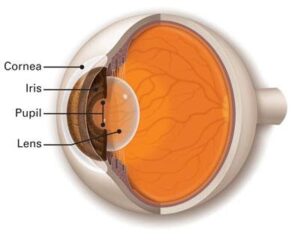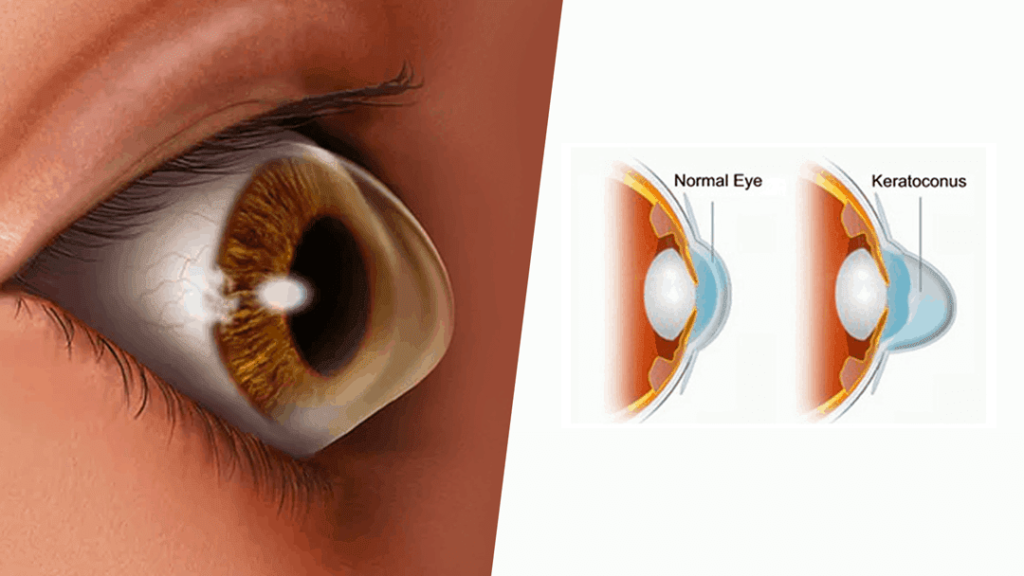Cornea
About Cornea
What is a Cornea?
The cornea is the clear, outer layer of the eye. The cornea is clear to let light into the eye, and curved to focus the light rays on to the retina, thus enabling us to see clearly. Any disease affecting its clarity and curvature causes decreased vision.


What are Corneal Infections?

A corneal ulcer is an open sore in the cornea. It is usually produced by an infection, commonly bacterial, fungal or viral. Corneal infections are frequently associated with trauma, contact lens overuse and dry eyes. It causes pain, redness and watering in the eye which can be quite severe. Ulcers frequently require 2-3 months of intensive treatment with eye drops and / or tablets and heal by corneal scarring. If visual loss occurs, this may require corneal grafting later in future. If medical treatment fails, pus formation, corneal perforation may require therapeutic corneal grafting to save the eye.
What is a KERATOCONUS?

A corneal ulcer is an open sore in the cornea. It is usually produced by an infection, commonly bacterial, fungal or viral. Corneal infections are frequently associated with trauma, contact lens overuse and dry eyes. It causes pain, redness and watering in the eye which can be quite severe. Ulcers frequently require 2-3 months of intensive treatment with eye drops and / or tablets and heal by corneal scarring. If visual loss occurs, this may require corneal grafting later in future. If medical treatment fails, pus formation, corneal perforation may require therapeutic corneal grafting to save the eye.
Keratoconus is a disease where the cornea becomes thinner than normal, and subsequently starts bulging forwards. Keratoconus can be identified via symptoms of reduced vision, frequent change in glass power, double vision, high cylindrical number, and seeing halos & shadows around objects. Causes include recurrent allergies or constant habit of eye rubbing. Mostly, Keratoconus starts from childhood and progresses upto the age of 30-32 years.
Conclusions to the severity of this condition can only be drawn by a Corneal Topography done by Pentacam. It shows the alterations of the cornea and helps the specialists draw a successful treatment plan for the patient.
Treatment:- Medical management for treatment of allergic eye disease.
- Corneal collagen cross linking(C3R) helps halt the progression of keratoconus.
- Rigid gas permeable lenses or Scleral contact lens helps to improve the quality of vision.
- INTACS are ring segments that are inserted into the corneal stroma to alter the corneal curvature.
- Deep anterior lamellar keratoplasty(DALK) or Penetrating Keratoplasty may be required in advanced cases as a last resort.

What is a Corneal Transplantation?
Corneal grafting medically termed Keratoplasty, is an operation where a diseased cornea is replaced by a clear cornea donated by another person after death. Keratoplasty is of 2 types, Full-thickness and Partial-thickness lamellar.
Full thickness Penetrating Keratoplasty gives satisfactory results but requires a lot of care after surgery. Stitch removal starts after 5-6 months and visual rehabilitation takes between 6 months to 1 year. Strict follow-up is required for first 6 months. Rejection and infection needs to be guarded against. Glasses or contact lenses are required after stitches removal for visual improvement.
Decemet’s stripping endothelial keratoplasty (DSEK) is a recent procedure where only the innermost, diseased endothelial layer is replaced by a healthy one. The advantage of this procedure is faster visual recovery and lesser chances of corneal rejection.


